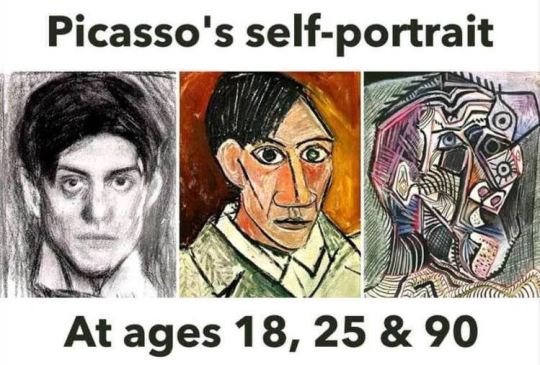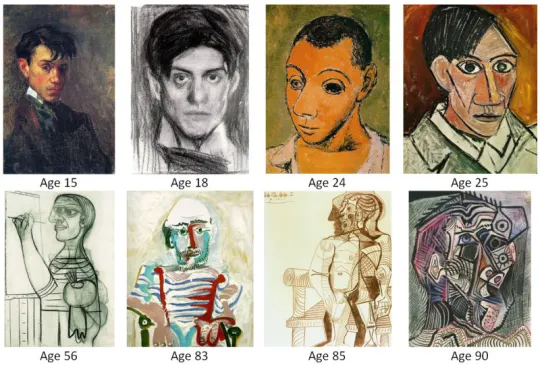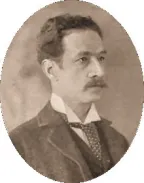Was Pablo Picasso Schizophrenic?
A couple of weeks ago, as I was browsing my Facebook news feed, a friend of mine posted some of Picasso’s self-portraits:

I found these images fascinating because they were instantly familiar. They reminded me of something I saw in one of my psychology textbooks: a series of cat drawings, drawn by someone who was suffering from schizophrenia. Luckily, my psychology textbook was still in my bookcase, so here are those images:

The accompanying text reads “Some drawings of cats, done by Louis Wain (1860-1939) in the 1920s over the course of his illness, suggesting the progressive distortions in perception and/or thought characteristic of schizophrenia.“
The similarities were remarkable, so obviously I started wondering: did Pablo Picasso suffer from schizophrenia? Was his incomprehensible style, which so many people have assumed was the work of a brilliant mind, a manifestation of a progressive neuro-degenerative disorder?
Obviously, I couldn’t make any assumptions… this was a Facebook post, after all, and anyone can post whatever they like on their news feed. Therefore, anything I see on Facebook (or on any form of social media) is automatically suspect until I can personally verify it. So I did a little searching, and found a number of web sites that backed up this post. This one includes Picasso’s self-portraits, drawn throughout his life from age 15-90. Everything checked out; my hypothesis was looking promising!

Since Picasso’s progressive perceptual distortions seemed strikingly similar to Louis Wain’s cat drawings, and I was now convinced that I was onto something. The social media angle was now verified, so I knew that these were in fact Picasso’s self-portraits. As for Louis Wain’s cat drawings… well, those have to be true. Who is going to question the information in a university psychology textbook?
Actually, I’m going to question it. In fact, I had to, if I wanted to be thorough in my research. As I resumed my Google searches, I wasn’t expecting to find very much, since Louis Wain was born in 1860. However, I was astonished by the volume of information about Louis Wain and his cat drawings that was available online.
The first thing I discovered was the original series of eight drawings (in colour). These were compiled by Dr. Walter Maclay, who was studying the effects of mental disorders on art:

.
 Next, I pieced together a biography. Louis Wain was born in London, England, on August 5, 1860. He was the eldest of six children. Between 1877 and 1880, Louis studied at the West London School of Art from 1877-80, and then became an assistant teacher there until 1882, when he then started working for the Illustrated Sporting and Dramatic News. Wain was an art journalist, as well as a freelance illustrator. His illustrations included English country houses and estates as well as livestock, but Wain began to make a name for himself with his cat drawings, which he drew for the Illustrated London News. His drawing were both humourous and anthropomorphic – the cats were not only clothed, but also doing human things such as serving tea, playing cricket, fishing and riding bicycles. Wain drew several hundred drawings each year, and illustrated about one hundred children’s books. His youngest sister, at age 30, was declared insane and was committed to a mental asylum.
Next, I pieced together a biography. Louis Wain was born in London, England, on August 5, 1860. He was the eldest of six children. Between 1877 and 1880, Louis studied at the West London School of Art from 1877-80, and then became an assistant teacher there until 1882, when he then started working for the Illustrated Sporting and Dramatic News. Wain was an art journalist, as well as a freelance illustrator. His illustrations included English country houses and estates as well as livestock, but Wain began to make a name for himself with his cat drawings, which he drew for the Illustrated London News. His drawing were both humourous and anthropomorphic – the cats were not only clothed, but also doing human things such as serving tea, playing cricket, fishing and riding bicycles. Wain drew several hundred drawings each year, and illustrated about one hundred children’s books. His youngest sister, at age 30, was declared insane and was committed to a mental asylum.
There is some disagreement regarding the origin of Wain’s schizophrenia. Wain became schizophrenic after the death of his sister, Caroline in 1917. However, other family members believe that his schizophrenia began after he fell off a bus and struck his head. It was also thought that it may have been Toxoplasmosis, caused by a parasite called Toxoplasma gondii, which cats excrete in their feces. As the disease progressed, Wain’s behaviour became increasingly erratic and occasionally violent. He was committed to a mental institution in 1924. He continued drawing until his death in 1939. Wain was buried at St. Mary’s Catholic Cemetery in London. Biography credits: Paul Hussey and Wikipedia.
Now, here’s where things started to get interesting… there is a lot of debate about the veracity of the schizophrenia assumption.
- Dr. Michael Fitzgerald suggested that Wain didn’t have schizophrenia, but suffered from Asperger’s Syndrome. He explained that Wain’s “technique and skill as a painter did not diminish, as one would expect from a person with schizophrenia“.
- Aidan McGennis pointed out “elements of visual agnosia are demonstrated in his painting. If Wain had visual agnosia, it might have manifested itself merely as an extreme attention to detail“
- Rodney Dale, in his biography Louis Wain: The Man Who Drew Cats points out “with no evidence of the order of their progression, [Dr. Walter] Maclay arranged them in a sequence which clearly demonstrated, he thought, the progressive deterioration of the artist’s mental abilities“. Dale then added “there is clear no justification for regarding them as more than samples of Louis Wain’s art at different times. Wain experimented with patterns and cats, and even quite late in life was still producing conventional cat pictures, perhaps 10 years after his ‘later’ productions which are patterns rather than cats.“
- Finally, this blog poster, while not an academic, viewed Wain’s cat drawings and made the following observation, based on his own personal experience “I have schizophrenia and I know for a fact his drawing getting more abstract has nothing to do with his psychosis. I’m an artist too and all that happens to your drawings when things get bad is you don’t feel like making art.“
For me, these items together constitute reasonable doubt. Since my hypothesis was based on the correlation of Wain’s increasingly bizarre drawings with the progression of his schizophrenia, I no longer have a solid argument to make if the chronology of Louis Wain’s cat drawings can’t be verified.
More importantly, my little exploration also reinforced the value of critical thinking: don’t assume that any information source is infallible, and don’t be awed by any article’s academic provenance. Check things out yourself and validate the information from as many different sources as possible.
There were two components in my Picasso/Wain comparison: the social media post of Picasso’s self-portraits and Louis Wain’s cat drawings from my psychology textbook. Obviously the social media post needed to be verified, but who could have guessed that there was erroneous information in a university textbook? I had always assumed that textbooks were beyond reproach. Now I know better. While I’m a little disappointed that my schizophrenia angle didn’t pan out, I feel that I have now become a more disciplined critical thinker for exercising my due diligence.
Was Picasso a creative genius? Was his unique style a manifestation of a progressive neuro-degenerative disease? It looks like that answer will remain a mystery, as our fascination with this legendary artist continues…
.
.



